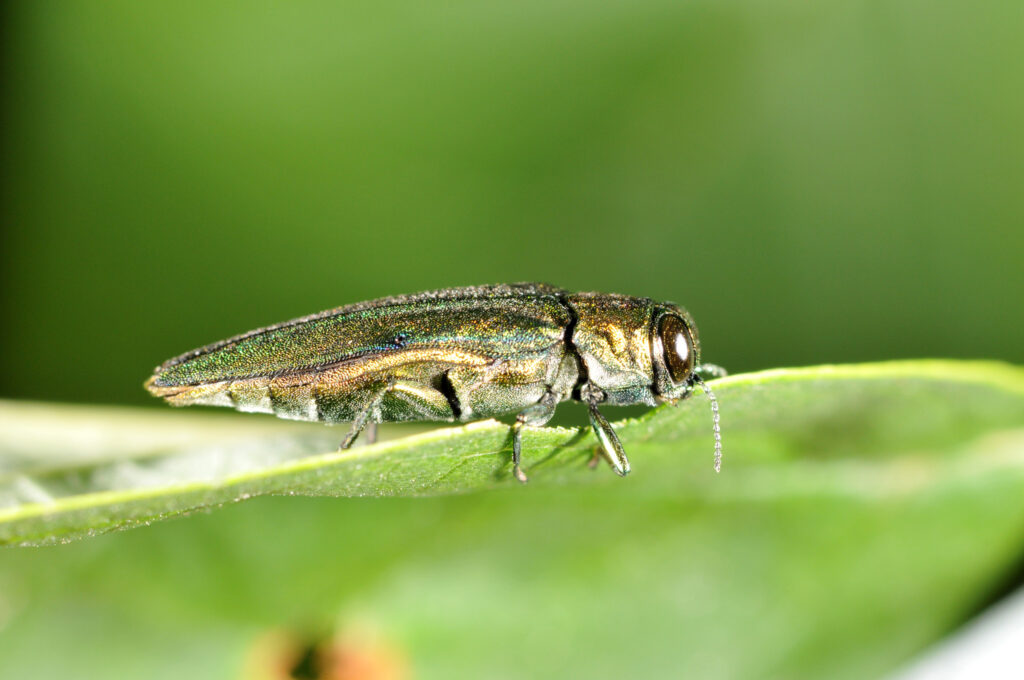Emerald ash borer moves south
Invasive insect confirmed in five new Texas counties
Texas A&M Forest Service confirmed the presence of the invasive emerald ash borer, EAB, in Grayson, Hill, Hood, McLennan and Palo Pinto counties. The pest is infesting and killing ash trees in new areas of the state and continues to spread south.
“The spread of EAB to these counties is alarming,” said Allen Smith, Texas A&M Forest Service regional forest health coordinator. “It’s more likely for EAB to spread to adjacent counties, but the spread to McLennan County indicates they are being spread by humans, which can be prevented.”
Adult specimens suspected to be emerald ash borers were collected from each of the five counties earlier this month. Texas A&M Forest Service sent them to the U.S. Department of Agriculture Animal and Plant Health Inspection Service national lab for confirmatory identification. Lab results for all specimens tested positive.

Emerald ash borer is a destructive, non‐native, wood‐boring pest that targets ash trees. Native to Asia, forest health experts have been monitoring its movement across the U.S. since 2002. It has spread to more than half the U.S. — and killed millions of ash trees. The beetle was first detected in Texas in 2016 in Harrison County. Since then, it has been positively confirmed in Bowie, Camp, Cass, Cooke, Dallas, Denton, Marion, Morris, Parker, Rusk, Tarrant, Titus and Wise counties.
Monitoring emerald ash borer spread
Texas A&M Forest Service sets traps and proactively monitors for the emerald ash borer annually.
“Since 2018, we have deployed nearly 500 traps across Central, East and North Texas watching for the insect’s presence and movement,” Smith said. “Both healthy and unhealthy ash trees are susceptible to EAB attack and have no natural resistance to the invasive insect. Without proper proactive measures, mortality can be 100% in heavily infested areas — so early detection could improve our chances to manage for the pest.”
Once the presence of emerald ash borer is confirmed in a county, the Texas Department of Agriculture, TDA, assumes regulatory responsibility, which includes the establishment of quarantines. The state’s mandatory quarantine by TDA restricts movement of any woody ash material exiting the county or quarantined area.
Because the insect is transported unintentionally on firewood and wood products, the quarantine helps slow the beetle’s spread by restricting the movement of wood in and out of affected areas, said Demian Gomez, Texas A&M Forest Service regional forest health coordinator.
Susceptible trees
All ash species are susceptible to the emerald ash borer. Infested trees die within two to five years after infestation.
“There is no known way to stop the spread of EAB,” said Gomez. “But we can help communities minimize loss, diversify their tree species and increase the health and resiliency of urban forests.”
Texas A&M Forest Service has resources available to help affected communities identify signs of emerald ash borer infestation, as well as make decisions about preventative measures they can take and how to handle tree management and removal.
The agency will work with communities on state quarantines of the movement of wood in and out of the area. These quarantines are standard protocols with such infestations and in Texas are set by TDA.
For more information on EAB in Texas, visit http://texasforestservice.tamu.edu/eab/.
For information from TDA on quarantines related to the emerald ash borer, visit https://tx.ag/EmeraldAshBorerInfo .
To report emerald ash borer, call the EAB Hotline at 1.866.322.4512.
Texas A&M Forest Service contacts
Demian Gomez, Regional Forest Health Coordinator, 512.339.4118, [email protected]
Allen Smith, Regional Forest Health Coordinator, 903.297.5094, [email protected]
Texas A&M Forest Service Communications Office, 979.458.6606, [email protected]





